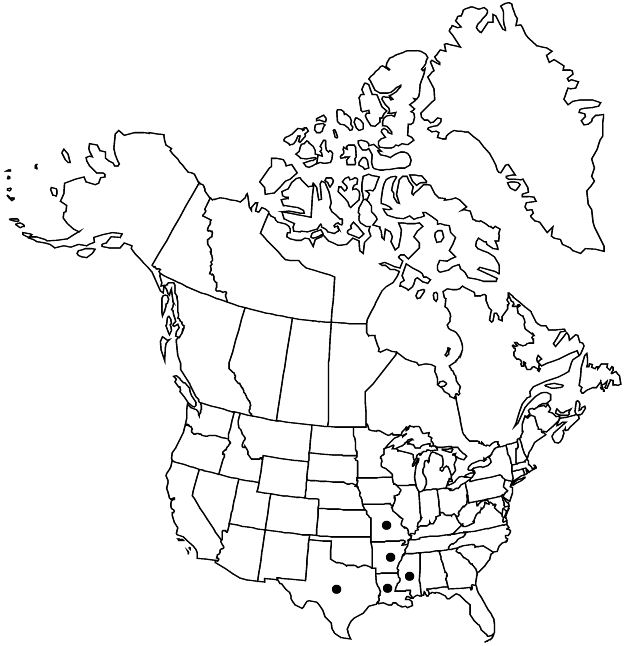Difference between revisions of "Crataegus viridis var. ovata"
Ann. Missouri Bot. Gard. 22: 561. 1935.
FNA>Volume Importer |
FNA>Volume Importer |
||
| Line 21: | Line 21: | ||
|name=C. blanda | |name=C. blanda | ||
|authority=Sargent | |authority=Sargent | ||
| − | }}{{Treatment/ID/Synonym | + | }} {{Treatment/ID/Synonym |
|name=C. larga | |name=C. larga | ||
|authority=Sargent | |authority=Sargent | ||
| Line 39: | Line 39: | ||
|elevation=10–200 m | |elevation=10–200 m | ||
|distribution=Ark.;La.;Miss.;Mo.;Tex. | |distribution=Ark.;La.;Miss.;Mo.;Tex. | ||
| − | |discussion=<p>The range of var. ovata is not precisely documented and may be wider than noted. The variety appears to be well represented in Arkansas and Louisiana. The type specimen is of a rare form with particularly large leaves, some distinctively lobed, that is restricted to Missouri. A form with smaller and almost always unlobed leaves, also included here, is the most abundant of this variety. Intermediates with var. lanceolata and var. viridis are common. Forms with black scaly bark, relatively large flowers (said to be 20 mm diam.), thornless, and upland habitat were referred to Crataegus blanda, though specimens from the type tree have smaller (14–15 mm diam.) flowers. As the bark of C. viridis characteristically exfoliates in large flakes and is usually whitish or pale gray, the topland habitat of C. blanda, as well as the original collector’s comments on its bark, and its type, which cannot be differentiated from var. ovata in the herbarium, suggest that the nature of the mature bark may need to be taken into account more seriously in the taxonomy of this species. Rare ovata-like forms with pink anthers and growing in atypically dry habitats in northeastern Missouri, perhaps hybrid, may be referred to C. davisii Sargent and C. pechiana Sargent and perhaps no longer exist.</p> | + | |discussion=<p>The range of <i></i>var.<i> ovata</i> is not precisely documented and may be wider than noted. The variety appears to be well represented in Arkansas and Louisiana. The type specimen is of a rare form with particularly large leaves, some distinctively lobed, that is restricted to Missouri. A form with smaller and almost always unlobed leaves, also included here, is the most abundant of this variety. Intermediates with <i></i>var.<i> lanceolata</i> and <i></i>var.<i> viridis</i> are common. Forms with black scaly bark, relatively large flowers (said to be 20 mm diam.), thornless, and upland habitat were referred to <i>Crataegus</i> blanda, though specimens from the type tree have smaller (14–15 mm diam.) flowers. As the bark of <i>C. viridis</i> characteristically exfoliates in large flakes and is usually whitish or pale gray, the topland habitat of <i>C. blanda</i>, as well as the original collector’s comments on its bark, and its type, which cannot be differentiated from <i></i>var.<i> ovata</i> in the herbarium, suggest that the nature of the mature bark may need to be taken into account more seriously in the taxonomy of this species. Rare ovata-like forms with pink anthers and growing in atypically dry habitats in northeastern Missouri, perhaps hybrid, may be referred to <i>C. davisii</i> Sargent and C. pechiana Sargent and perhaps no longer exist.</p> |
|tables= | |tables= | ||
|references= | |references= | ||
| Line 63: | Line 63: | ||
|publication year=1935 | |publication year=1935 | ||
|special status=Endemic;Selected by author to be illustrated | |special status=Endemic;Selected by author to be illustrated | ||
| − | |source xml=https://jpend@bitbucket.org/aafc-mbb/fna-data-curation.git/src/ | + | |source xml=https://jpend@bitbucket.org/aafc-mbb/fna-data-curation.git/src/8f726806613d60c220dc4493de13607dd3150896/coarse_grained_fna_xml/V9/V9_895.xml |
|subfamily=Rosaceae subfam. Amygdaloideae | |subfamily=Rosaceae subfam. Amygdaloideae | ||
|tribe=Rosaceae tribe Gillenieae | |tribe=Rosaceae tribe Gillenieae | ||
Revision as of 18:19, 18 September 2019
Stems: trunk bark gray, ± exfoliating, smooth; 1-year old twigs reddish brown. Leaves: blade broadly elliptic to oblong-ovate, sometimes suborbiculate, 2.5–6.3 cm, thin, base broadly or acutely concave-cuneate, lobes 0 or 1 per side, very short, else rarely 1 per side, distinct, but not on most leaves, usually very short, sinuses shallow, max LII 5(–20)%, lobe apex obtuse, margins finely crenate-serrate, rarely serrate, except base entire, teeth 1 mm, venation craspedodromous, sometimes semicamptodromous, veins 4 or 5 per side, midvein slender, apex subacute to acute, surfaces glabrous except abaxially with persistent axillary tufts of hairs, adaxially with scattered hairs near base of midvein. Inflorescences: branches glabrous. Flowers: hypanthium glabrous.
Phenology: Flowering early May; fruiting Oct.
Habitat: Moist, fertile, alluvial woodlands, agricultural derivatives of these
Elevation: 10–200 m
Distribution

Ark., La., Miss., Mo., Tex.
Discussion
The range of var. ovata is not precisely documented and may be wider than noted. The variety appears to be well represented in Arkansas and Louisiana. The type specimen is of a rare form with particularly large leaves, some distinctively lobed, that is restricted to Missouri. A form with smaller and almost always unlobed leaves, also included here, is the most abundant of this variety. Intermediates with var. lanceolata and var. viridis are common. Forms with black scaly bark, relatively large flowers (said to be 20 mm diam.), thornless, and upland habitat were referred to Crataegus blanda, though specimens from the type tree have smaller (14–15 mm diam.) flowers. As the bark of C. viridis characteristically exfoliates in large flakes and is usually whitish or pale gray, the topland habitat of C. blanda, as well as the original collector’s comments on its bark, and its type, which cannot be differentiated from var. ovata in the herbarium, suggest that the nature of the mature bark may need to be taken into account more seriously in the taxonomy of this species. Rare ovata-like forms with pink anthers and growing in atypically dry habitats in northeastern Missouri, perhaps hybrid, may be referred to C. davisii Sargent and C. pechiana Sargent and perhaps no longer exist.
Selected References
None.
